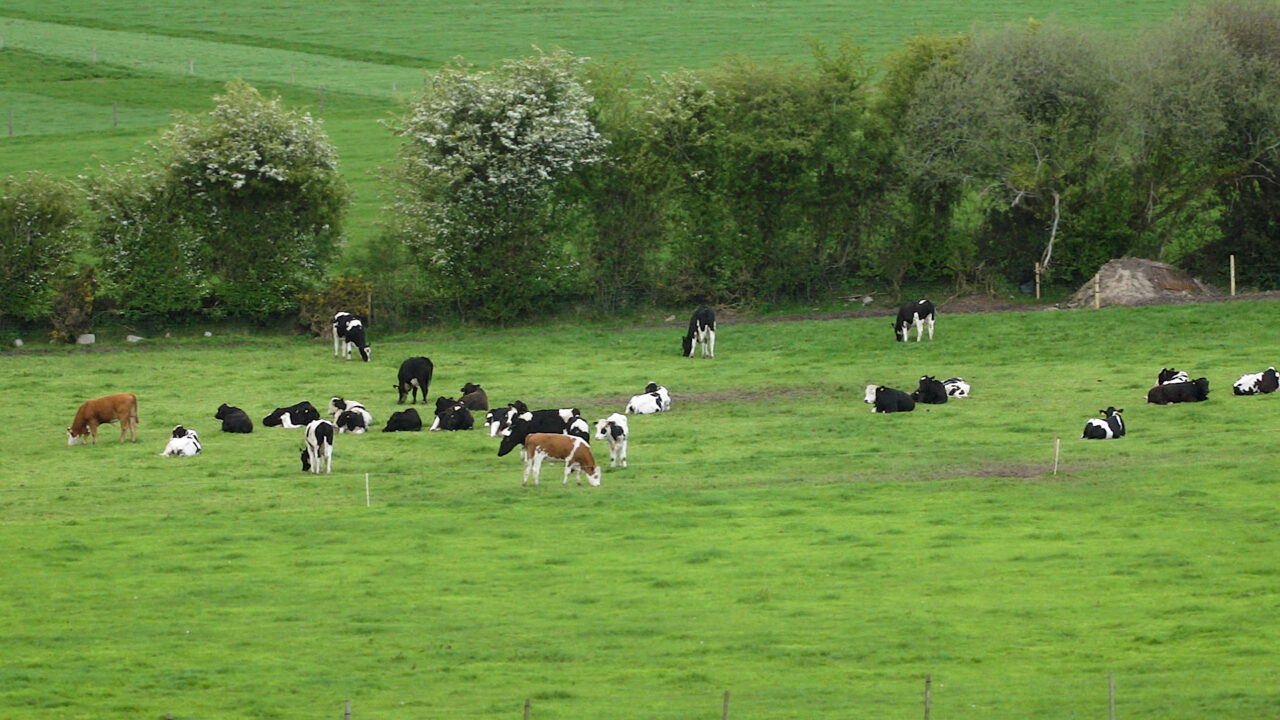Today, Tuesday, May 21, crowds gathered at Teagasc Johnstown Castle, Co. Wexford, for DairyBEEF2019, where one of the key focuses was growing and utilising more grass – the cheapest feed source for calf-to-beef farmers.
Speaking in the grassland village, Teagasc researcher Nicky Byrne outlined that for every 1t of dry matter (DM) utilised, this is equal to €105 net profit/ha.
In Ireland, beef farms are stocked at 1.1LU/ha, but there is considerable scope to increase stocking rate across beef systems depending on the farms ability to grow and utilise grazed grass.
Nationally, across drystock farms, grass utilisation is low at an estimated 5.6t DM/ha, which is only 58% of its potential.
Nicky highlighted that good grassland management will help grow more grass. To maximise grass production and utilisation, grazing management; soil fertility; drainage; paddock infrastructure; and sward composition need to be optimised and better managed on farms.
In addition, central to the success of calf-to-beef systems is regular measurement of grass to ensure its supply and quality throughout the grazing season.
Extended grazing season
Nicky also explained the importance of turning priority stock out to grass early in the year. Spring grass is highly digestible, high in protein and DM content and will support higher animal performance.
Dairy calf-to-beef systems must be focused on utilising early spring grass to achieve higher animal performance and displace concentrate use.
In general, calf-to-beef systems are in a good position to start grazing early in the spring as yearlings are relatively light minimising sward damage and they will have a low grass DM demand initially.
Furthermore, aside from increased animal performance, paddocks grazed in spring have higher growth rates throughout the year compared to swards un-grazed during this period.
Nicky outlined how grassland should be managed during different times of the year – spring, mid-season and in autumn.
In spring, average farm cover (AFC) at turnout should be 600-700kg DM/ha. The spring rotation planner should be followed, with an aim of having 30% of the farm grazed by March 1, 60% by March 17 and first rotation complete by April 1.
However, on heavy soils these targets can be reduced by 10% for the respective dates.
- Follow rotation planner;
- Turnout priority stock;
- AFC: 600-700kg DM/ha;
- 1,000-1,300kg DM/ha (8-9cm);
- Tight grazing: 3.5cm;
- Rotation length: 45 days.
During the summer months, the main challenge mid-season is to maintain sward quality as grass goes through the reproductive growth stage.
Weekly farm cover measurement is critical at this point as grass growth is high, requiring a rotation length of 18-21 days and maintaining pre-grazing covers of 1,300-1,600kg DM/ha and a post-grazing height of 4-4.5cm.
Farmers that measure grass can identify when growth will exceed demand which in turn allows paddocks to be skipped and removed as high-quality baled silage for the winter period.
- 1,300-1,600kg DM/ha (9-10cm);
- 18-21 day rotation;
- Post-grazing height 4-4.5cm.
Moving to autumn management, Nicky outlined that planning for spring begins the previous autumn as the majority of grass available for early grazing will grow over the autumn/winter months.
The feed value of autumn grass is less than that of spring grass, so there are many advantages to preserving its supply for the following spring when higher levels of animal performance are achievable.
Grass has to be budgeted over the autumn to allow animals to remain outdoors until mid-November.
The ‘Autumn 60:40 planner’ is a simple tool used to manage grass supply, outlining the farm area which needs to be closed by set dates to ensure sufficient supply in spring, whilst allowing animals graze late into the autumn.
- Start building covers: Reduce demand and increase rotation length;
- Start closing paddocks: Autumn 60:40 planner;
- 1,500-2,000kg DM/ha (10-12cm);
- Tight grazing: 3.5cm;
- AFC on December 1: 550kg DM/ha.
In conclusion, Nicky noted that dairy calf-to-beef systems must focus on output/ha, optimising animal performance from a grass-based diet.
However, each farm is different and stocking rate should be dependent on the ability to grow and utilise grass with minimal concentrate feed.
To achieve this, farms must be set up for grazing, with good paddock and roadway infrastructure to aid in grassland management. Grass measurement and budgeting is important to ensure the supply and quality of grass throughout the grazing season.
- Profitable calf-to-beef production is based on utilising large quantities of grazed grass to produce beef at low cost;
- Stocking rate is dependent on the farms ability to grow and utilise grass;
- Early spring grazing is necessary to promote increased sward and animal performance;
- Grazing infrastructure will help maximise grass utilisation;
- To increase grass utilisation, pre-grazing herbage mass, post-grazing sward height and rotation length need to be well managed;
- Grass measurement and budgeting are key elements of grazing management.




